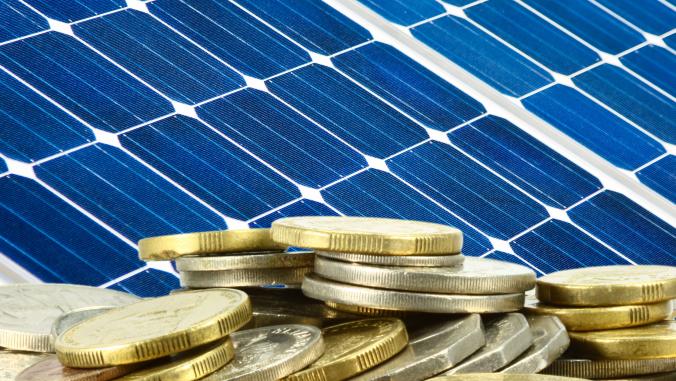Investors Clamor for Binding Climate Change Agreement in Copenhagen
<p>A group of 181 institutional investors representing $13 trillion in assets calls a global agreement necessary to boost comfidence in climate change mitigation investment.</p>

Calling on "world leaders to reach a strong post-2012 climate change agreement in Copenhagen in December," a group of 181 institutional investors with $13 trillion in assets under management issued a statement Wednesday outlining the risks and opportunities of climate change, and offers a number of recommendations for inclusion in a global climate agreement.
The statement, entitled "2009 Investor Statement on the Urgent Need for a Global Agreement on Climate Change," is available for download from the website of Ceres, a network of investors, environmental organizations and other public interest groups that address sustainability issues. Ceres is the coordinator of the Investor Network on Climate Risk (INCR), a network of institutional investors and financial institutions and one of the producers of the Investor Statement.
Other organizations involved in the production of the Statement include the Institutional Investors Group on Climate Change (IIGCC), the Investor Group on Climate Change/Australia and New Zealand (IGCC), and the UNEP Finance Initiative (UNEP FI).
In a press conference convened at the International Investor Forum on Climate Change in New York City to announce the issue of the statement, Thomas P. DiNapoli, Comptroller of the State of New York and head of the $116.5 billion New York State Common Retirement Fund, said, "The vast number of scientists agrees that climate change is real, and is accelerating. Potential economic losses due to climate change could reach as high as 20 percent of global Gross Domestic Product (GDP). Investors and policymakers must commit the necessary resources to reducing emissions and developing a sustainable global economy."
DiNapoli continued, "The mitigation process will create significant opportunities for sustained economic growth."
Lord Nicholas Stern, chair of the Grantham Research Institute on Climate Change at the London School of Economics, said, "The scale of change we have to make does entail having to make radical changes in the way we produce electricity and use transportation. It will be a transformation of how we do things, and this is an enormous investment opportunity."
The statement asserts that investors will continue to play a decisive role in the global response to climate change, because "private capital is essential to achieving the transformation to a low-carbon economy and for contributing to the delivery of mitigation and adaptation measures." Yet investment decision-making has been hampered by policy uncertainty, and a binding climate change agreement must be reached at the United Nations Framework Convention on Climate Change in December, in order for "investors to integrate climate change considerations into their decision-making processes and to support investment flows into a low-carbon economy and into measures for adaptation."
Mindy S. Lubber, president of Ceres and director of the INCR, said, "The successes of institutional investors have been laudable, but they are a mere drop in the ocean of what we have to accomplish. Investors need policies that create stable market conditions. Political leaders need to have the courage to act."
Addressing the U.S. Senate, where the American Clean Energy and Security Act that passed the U.S. House of Representatives June is under consideration, Lubber said, "Do not delay in passing critical cap-and-trade legislation this fall. Do not squander this opportunity."
The statement supports the global greenhouse gas (GHG) emissions reduction target recommended by the Intergovernmental Panel on Climate Change (IPCC) in its Fourth Assessment Report (AR4), of 50-85 percent by 2050 against a base year of 2000. Furthermore, the statement calls on developed countries to reduce their emissions by 80-95 percent by 2050, with interim emissions reduction targets of 25-40 percent by 2020 against a base year of 1990. It notes that "targets for developed countries will only be credible if backed up by clear national action plans that lay out how different countries will meet their medium- and long-term targets."
Acknowledging that the role of developing countries in an international agreement to address climate change must be "fair and based on common but differentiated responsibilities," the statement does point out that "from an investment perspective, it is critical that developing countries, especially the highest emitters, commit to such targets as soon as possible to reduce policy uncertainty and drive low-carbon investment."
Rob Lake of the IIGCC said, "We invest in the entirety of the global economy. To drive money into developing countries in particular, international institutions like the World Bank must provide risk mitigation mechanisms to enable the private sector to put money into emerging markets."
The statement lists a number of policy instruments that nations should consider while enacting policies to reduce GHG emissions. Incentives to invest in low-carbon technologies such as energy efficiency and renewable energy should be offered, and the transfer of technology to developing countries should be encouraged.
Asserting that "emissions trading provides a cost-effective way to achieve absolute emission reductions and significantly reduces mitigation costs," the statement calls for the continuation of cap-and-trade programs, as well as a review of the Clean Development Mechanism (CDM), "to ensure the quality, scale and efficiency of emission reductions generated in developing countries."
The CDM was created to assist developed countries in the practice of offsetting GHG emissions from developed countries, by investment in projects in developing countries.
Governments in developed countries should also consider public funding mechanisms, by which "private money can be leveraged by the public sector for technology deployment in developing countries."
Other elements of a climate change agreement urged by the signatories of the statement include support for measures to reverse deforestation, and support for adaptation to the physical risks of climate change.
"Adaptation to climate change that is already locked in represents investment opportunities as well," said Lake of the IIGCC.
But, Lake concluded, "The single most important thing that will drive investors to investing on a larger scale in the technologies needed to address climate change is long, loud, and legal signals from governments at a national level."
This article originally appeared at SocialFunds.com.





